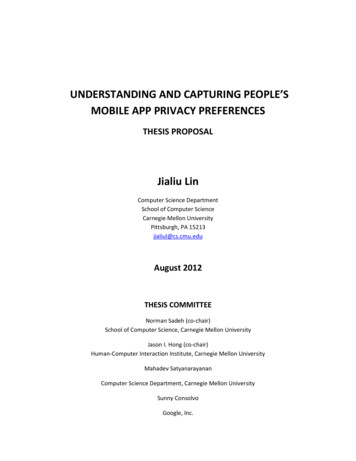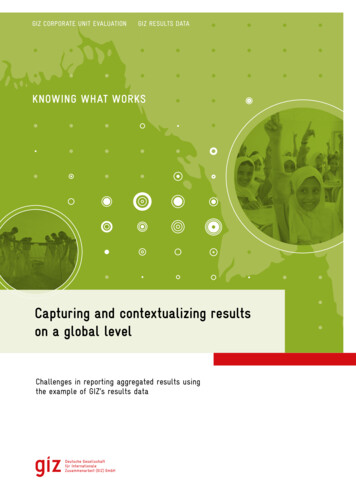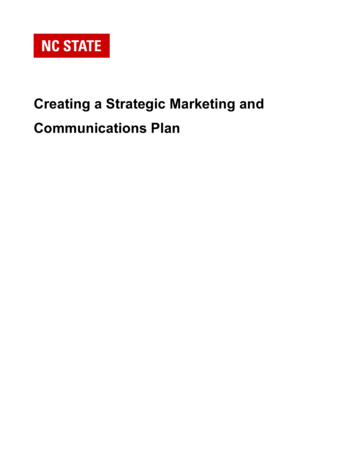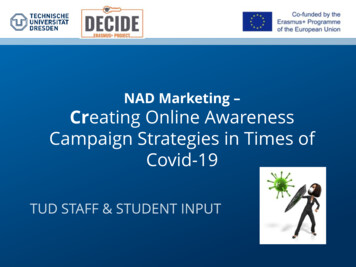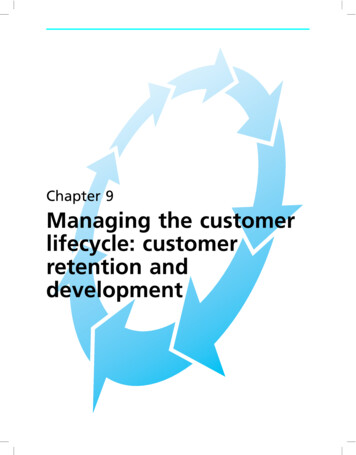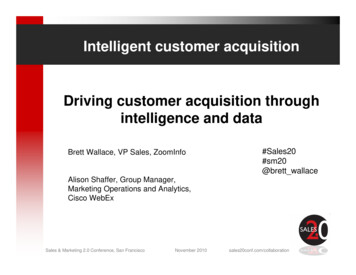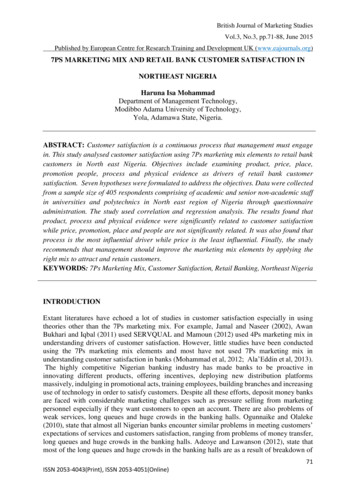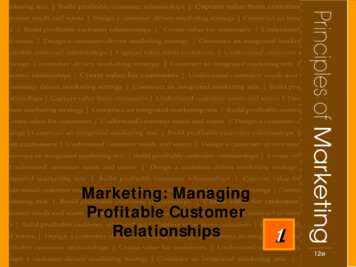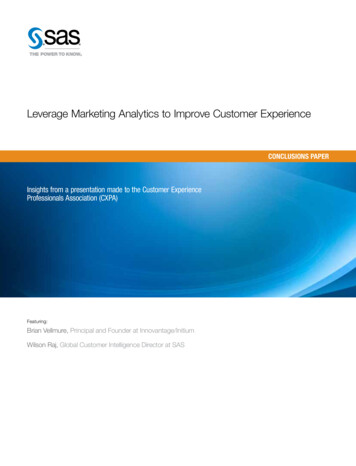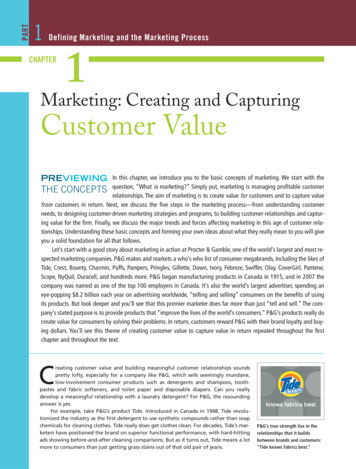
Transcription
PART1Defining Marketing and the Marketing ProcessCHAPTER1Marketing: Creating and CapturingCustomer ValuePREVIEWINGIn this chapter, we introduce you to the basic concepts of marketing. We start with theTHE CONCEPTS question, “What is marketing?” Simply put, marketing is managing profitable customerrelationships. The aim of marketing is to create value for customers and to capture valuefrom customers in return. Next, we discuss the five steps in the marketing process—from understanding customerneeds, to designing customer-driven marketing strategies and programs, to building customer relationships and capturing value for the firm. Finally, we discuss the major trends and forces affecting marketing in this age of customer relationships. Understanding these basic concepts and forming your own ideas about what they really mean to you will giveyou a solid foundation for all that follows.Let’s start with a good story about marketing in action at Procter & Gamble, one of the world’s largest and most respected marketing companies. P&G makes and markets a who’s who list of consumer megabrands, including the likes ofTide, Crest, Bounty, Charmin, Puffs, Pampers, Pringles, Gillette, Dawn, Ivory, Febreze, Swiffer, Olay, CoverGirl, Pantene,Scope, NyQuil, Duracell, and hundreds more. P&G began manufacturing products in Canada in 1915, and in 2007 thecompany was named as one of the top 100 employers in Canada. It’s also the world’s largest advertiser, spending aneye-popping 8.2 billion each year on advertising worldwide, “telling and selling” consumers on the benefits of usingits products. But look deeper and you’ll see that this premier marketer does far more than just “tell and sell.” The company’s stated purpose is to provide products that “improve the lives of the world’s consumers.” P&G’s products really docreate value for consumers by solving their problems. In return, customers reward P&G with their brand loyalty and buying dollars. You’ll see this theme of creating customer value to capture value in return repeated throughout the firstchapter and throughout the text.Creating customer value and building meaningful customer relationships soundspretty lofty, especially for a company like P&G, which sells seemingly mundane,low-involvement consumer products such as detergents and shampoos, toothpastes and fabric softeners, and toilet paper and disposable diapers. Can you reallydevelop a meaningful relationship with a laundry detergent? For P&G, the resoundinganswer is yes.For example, take P&G’s product Tide. Introduced in Canada in 1948, Tide revolutionized the industry as the first detergent to use synthetic compounds rather than soapchemicals for cleaning clothes. Tide really does get clothes clean. For decades, Tide’s marketers have positioned the brand on superior functional performance, with hard-hittingads showing before-and-after cleaning comparisons. But as it turns out, Tide means a lotmore to consumers than just getting grass stains out of that old pair of jeans.P&G’s true strength lies in therelationships that it buildsbetween brands and customers:“Tide knows fabrics best.”
For several years, P&G has beenon a mission to unearth and cultivatethe deep connections that customershave with its products. Two years ago,P&G global marketing chief Jim Stengel mandated that the company’sbrandsmust“speakto consumers eye-to-eye” rather thanrelentlessly driving product benefits.“Weneedtothinkbeyondconsuming . . . and to really directlyunderstand the role and the meaningthe brand has in [consumers’] lives,”says Stengel. Behind this strategy liesthe realization that competitors canquickly copy product benefits, such ascleaning power. However, they can’teasily copy how consumers feel abouta brand. Consequently, P&G’s truestrength lies in the relationships thatP&G is on a mission to unearth and cultivate the deep connections that customers have with itsit builds between its brands and cusproducts. Can you really develop a meaningful relationship with a laundry detergent? For P&G, thetomers.resounding answer is yes.Under this mandate, the Tidemarketing team decided that itshopped, and ran errands, and they sat in on discussions toneeded a new message for the brand. Tide’s brand share, alhear women talk about what’s important to them. “We gotthough large, had been stagnant for several years. Also, as ato an incredibly deep and personal level,” says a Tide marketresult of its hard-hitting functional advertising, consumersing executive. “We wanted to understand the role of laundrysaw the Tide brand as arrogant, self-absorbed, and veryin their life.” But “one of the great things,” adds a Saatchimale. The brand needed to recapture the hearts and mindsstrategist, “is we didn’t talk [to consumers] about their launof its core female consumers.dry habits [and practices]. We talked about their lives, whatSo the team set out to gain a deeper understanding oftheir needs were, how they felt as women. And we got a lotthe emotional connections that women have with their launof rich stuff that we hadn’t tapped into before.”dry. Rather than conducting the usual focus groups and reFor members of the Tide team who couldn’t join thesearch surveys, however, marketing executives and strategiststwo-week consumer odyssey, including Saatchi’s creativefrom P&G and its longtime ad agency, Saatchi & Saatchi, wentpeople, the agency videotaped the immersions, preparedinto a two-week consumer immersion. They tagged alongscripts, and hired actresses to portray consumers in an hourwith women in North American cities as they worked,long play entitled Pieces of Her. “They were actually veryOBJECTIVES1Define marketing and outline the steps in the marketing process.2Explain the importance of understanding customers and the marketplace, and identify the five coremarketplace concepts.3Identify the key elements of a customer-driven marketing strategy and discuss the marketingmanagement orientations that guide marketing strategy.4Discuss customer relationship management and identify strategies for creating value for customersand capturing value from customers in return.5Describe the major trends and forces that are changing the marketing landscape in this age ofrelationships.왘
4Part 1 Defining Marketing and the Marketing Processgood actresses who brought to life many dimensions ofwomen,” says the Saatchi executive. “It’s difficult to inspirecreatives sometimes. And [their reaction to the play] wasincredible. There was crying and laughing. And you can seeit in the [later] work. It’s just very connected to women.”From the customer immersions, the marketers learnedthat, although Tide and laundry aren’t the most importantthings in customers’ lives, women are very emotionalabout their clothing. For example, there was the joy a plussize, divorced woman described when she got a whistlefrom her boyfriend while wearing her “foolproof (sexiest)outfit.” According to one P&G account, “Day-to-day fabrics in women’s lives hold meaning and touch them inmany ways. Women like taking care of their clothes andfabrics because they are filled with emotions, stories, feelings, and memories. The fabrics in their lives (anythingfrom jeans to sheets) allow them to express their personalities, their multidimensions as women, their attitudes.”Such insights impacted everything the brand did movingforward. Tide, the marketers decided, can do more thansolve women’s laundry problems. It can make a differencein something they truly care about—the fabrics that touchtheir lives.Based on these insights, P&G and Saatchi developedan award-winning advertising campaign built around thetheme “Tide knows fabrics best.” Rather than the unfeeling demonstrations and side-by-side comparisons of pastTide advertising, the new campaign employs rich visualimagery and meaningful emotional connections. For example, Toronto-based Saatchi & Saatchi Canada, whichcreates approximately 25 percent of Tide’s advertising inNorth America, developed the campaign for the launch of2x Ultra Tide featuring TV personality Kelly Ripa. This campaign has been among Tide’s strongest and most unusualwork in recent history, and Canadian consumers could relate to her and the values she personifies. The “Tideknows fabrics best” slogan says little about cleaning. Instead, the message is that Tide lets women focus on life’simportant things. “One of our rallying cries was to get outof the laundry basket and into [your] life,” says a Tidemarketer.The “Tide knows fabrics best” ads have just the rightmix of emotional connections and soft sell. In one TV commercial, a pregnant woman dribbles ice cream on the onelast shirt that still fits. It’s Tide with Bleach to the rescue, sothat “your clothes can outlast your cravings.” Another adshows touching scenes of a woman first holding a baby andthen cuddling romantically with her husband, all to thetune of “Be My Baby.” Tide with Febreze, says the ad, canmean “the difference between smelling like a mom andsmelling like a woman.” In a third ad, a woman plays withher daughter at a park, still in her white slacks from the office, thanks to her confidence in Tide with Bleach: “Yourwork clothes. Your play clothes. Yup, they’re the sameclothes,” the ad concludes. “Tide with bleach: For lookinggreat, it’s child’s play.” In all, the “Tide knows fabrics best”campaign shows women that Tide really does make a difference in fabrics that touch their lives.So . . . back to that original question: Can you develop arelationship with a laundry detergent brand? Some criticswonder if P&G is taking this relationship thing too seriously.“Everybody wants to elevate their brand to this kind ofmore rarefied level,” says one brand consultant, “but at theend of the day detergent is detergent.” But it’s hard toargue with success, and no brand is more successful thanTide. P&G’s flagship brand captures an incredible 43 percentshare of the cluttered and competitive laundry detergentmarket. That’s right, 43 percent and growing—including a7 percent increase in the year following the start of the“Tide knows fabrics best” campaign.If you asked Jim Stengel, he’d say that this kind of success comes from deeply understanding consumers and connecting the company’s brands to their lives. Stengel wantsP&G to be more than a one-way communicator with customers. He wants it to be “a starter of conversations and asolver of consumers’ problems.” “It’s not about telling andselling,” he says. “It’s about bringing a [customer] relationship mind-set to everything we do.”1Today’s successful companies have one thing in common: Like Procter & Gamble, theyare strongly customer-focused and heavily committed to marketing. These companiesshare a passion for understanding and satisfying customer needs in well-defined targetmarkets. They motivate everyone in the organization to help build lasting customer relationships based on creating value. P&G’s chief global marketer, Jim Stengel, puts it thisway: “If we’re going to make one big bet on our future—right here, right now—I’d say thatthe smart money is on building [customer] relationships.”21What Is Marketing?Marketing, more than any other business function, deals with customers. Although we willsoon explore more-detailed definitions of marketing, perhaps the simplest definition is thisone: Marketing is managing profitable customer relationships. The twofold goal of marketing is toattract new customers by promising superior value and to keep and grow current customersby delivering satisfaction.
Chapter 1 Marketing: Creating and Capturing Customer Value5Walmart has become the world’s largest retailer—and the world’s largest company—by delivering on its promise, “Save money. Live Better.” At Disney theme parks, “imagineers” work wonders in their quest to “make a dream come true today.” Apple fulfills itsmotto to “Think Different” with dazzling, customer-driven innovation that captures customer imaginations and loyalty. Its wildly successful iPod grabs more than 70 percent ofthe music player market; its iTunes music store captures nearly 90 percent of the songdownload business.3 Provigo, a supermarket chain owned by Loblaw that operatesmainly in Quebec, now has 110 outlets and employs 5700 people. It has built its businessby providing “quality, variety, and freshness throughout its stores,” along with the promise to make the lives of its customers easier by offering quick, courteous service alignedwith its customers’ needs. The company also knows the importance of being involved inits customers’ communities, and it focuses on providing financial assistance to the familiesof children who have physical or developmental challenges. These and other highly successful companies know that if they take care of their customers, market share and profitswill follow.Sound marketing is critical to the success of every organization. Canada’s top fivefirms of 20084 (ranked according to profitability), RBC, Manulife Financial, ThomsonReuters, EnCana, and BCE, make extensive use of marketing. But so do not-for-profit organizations such as universities, hospitals, museums, symphony orchestras, and evenchurches.You already know a lot about marketing—it’s all around you. Marketing comes to youin traditional forms: You see it in the abundance of products at your nearby shopping malland in the advertisements that fill your TV screen, spice up your magazines, or stuff yourmailbox. But in recent years, marketers have assembled a host of new marketing approaches, everything from imaginative websites, Internet chat rooms, and social networks,to interactive TV and your cellphone. These new approaches aim to do more than just blastout messages to the masses. They aim to reach you directly and personally. Today’s marketers want to become a part of your life and to enrich your experiences with theirbrands—to help you live their brands.At home, at school, where you work, and where you play you see marketing in almosteverything you do. Yet there is mu
question, “What ismarketing?” Simply put, marketing is managing profitable customer relationships.The aim of marketing is to create value forcustomers and to capture value fromcustomers in return. Next, we discuss the five steps in the marketing process—from understanding customerFile Size: 1MBPage Count: 36

